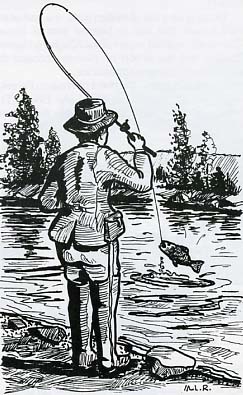
Click Here to Return to Milestones
One of the earliest forms of recreation - and possibly the earliest form of outdoor sport recorded in Beaver County and still one of the most popular (although now structured somewhat differently) is the sport of fishing.
"The Indians NEVER fished just for sport" according to Indian expert Monsignor Edward Ruzak.
"The streams and woods were their supermarket and they took only what they needed for food. " The early frontiersman's approach was similar to the Indians. But in a letter from Col. Josiah Harmar to Col. Francis Johnson' one can see another dimension - fishing for fun - creeping into the attitude of the white man toward a bountiful supply of fish. Dated Fort McIntosh, June 21st, 1785, It reads:
"I wish you were here to view the beauties of Fort McIntosh. What think you of pike Of 25 pounds, perch 15 to 20 pounds, catfish 40 pounds, bass, pickerel sturgeon, & ?. You would certainly enjoy yourself. It is very fortunate there is such an abundance of fish, as the contractor for this place sometime past has failed in his supply of beef."(1)
The countys two main bodies of water, the Ohio and the Beaver Rivers early on provided a natural abundance of fishing area. And the rolling hills also spawned innumerable springs that trickled into runs, creeks and streams that emptied into the rivers. Minnows, bluegills, shiners and horned chubs abounded in these tributaries, providing food for wild animals and larger fish. Some of these, like the horned chub's, were known to have grown to 10 inches in length.
An early record of the three branches of Little Beaver Creek, the north, middle and west forks also noted that "in their waters lived many bass, perch and catfish."
As late as the early 1900's stories of large fish in the rivers were told. But as the population grew and industry developed, pollution became a direct byproduct. Waste water was emptied directly into the streams and rivers. Fishing deteriorated, environmentalists began to make their voices heard. Ecology, though, was an unwelcomed word as it equated with job loss.
In 1903 the state of Pennsylvania's fish commission established three hatcheries at Bellfonte, Pa., the oldest being at Pleasant Gap. They began to experiment in the raising of rainbow trout. Early attempts to stock them in Beaver County failed.
The rainbow trout, a native of California, had qualities that became of great interest to Pennsylvania's sport fishermen.
The only native trout in Pennsylvania was the brook or speckled trout (Salvalinis Fontinalis) and it was not a true trout but a member of the char family. It was very elusive, but was not a battler like the rainbow. It never grew as large as and needed very cold water or would not survive. There is no record of the brookies; ever being native to Beaver County. In 1932 the fish commission again stocked the north fork of Little Beaver Creek and Big Traverse Creek. This time it proved successful and the restructuring of sport fishing in Beaver County was established. It is affectionately called "put and take" fishing. Stocking other streams and lakes, Big Sewickley, Mill Creek, Bradys Run Lake, Raccoon Lake and Herford Manor followed. Brown trout, natives of Germany, were also stocked.
In 1988, Raccoon Creek State Park, ranger Bill Smith said that about 8,400 people came to fish on opening day of trout season and about 12,000 on the second day. Thats over 20,000 people in two days at one spot. (Beaver County Times - Sunday, June 5, 1988) It's not easy to estimate the number of people that enjoy fishing every year. We've dwelt on trout fishermen here, but there are strictly bass' fishermen, walleye fishermen, etc. Adding them all together is sure to total an astronomical figure.

1 - Fort McIntosh -Its Times and Men, Daniel Agnew, LL.
D. Myers, Shinkle & Co. Pittsburgh 1893.